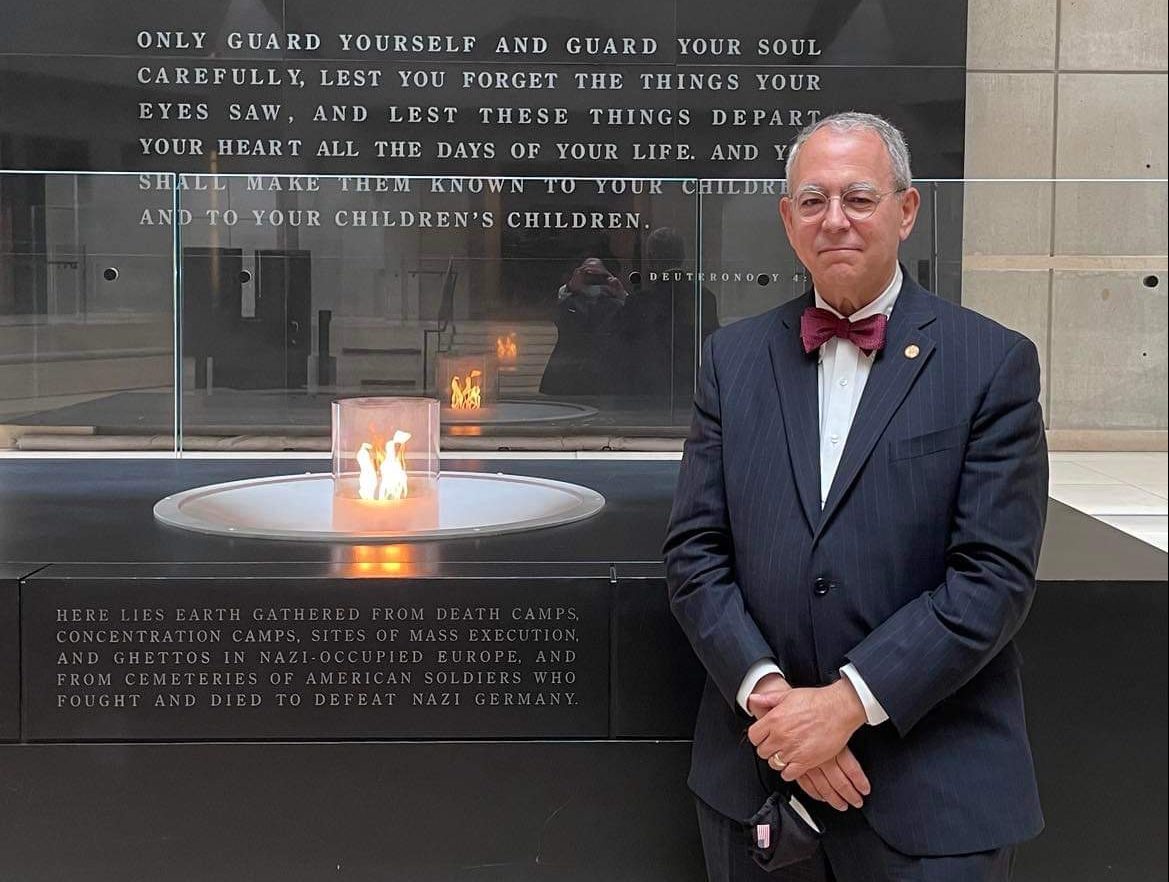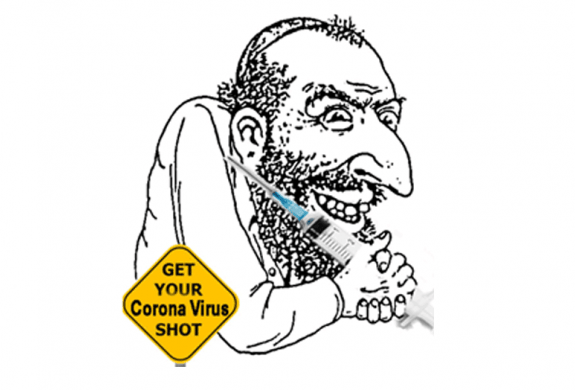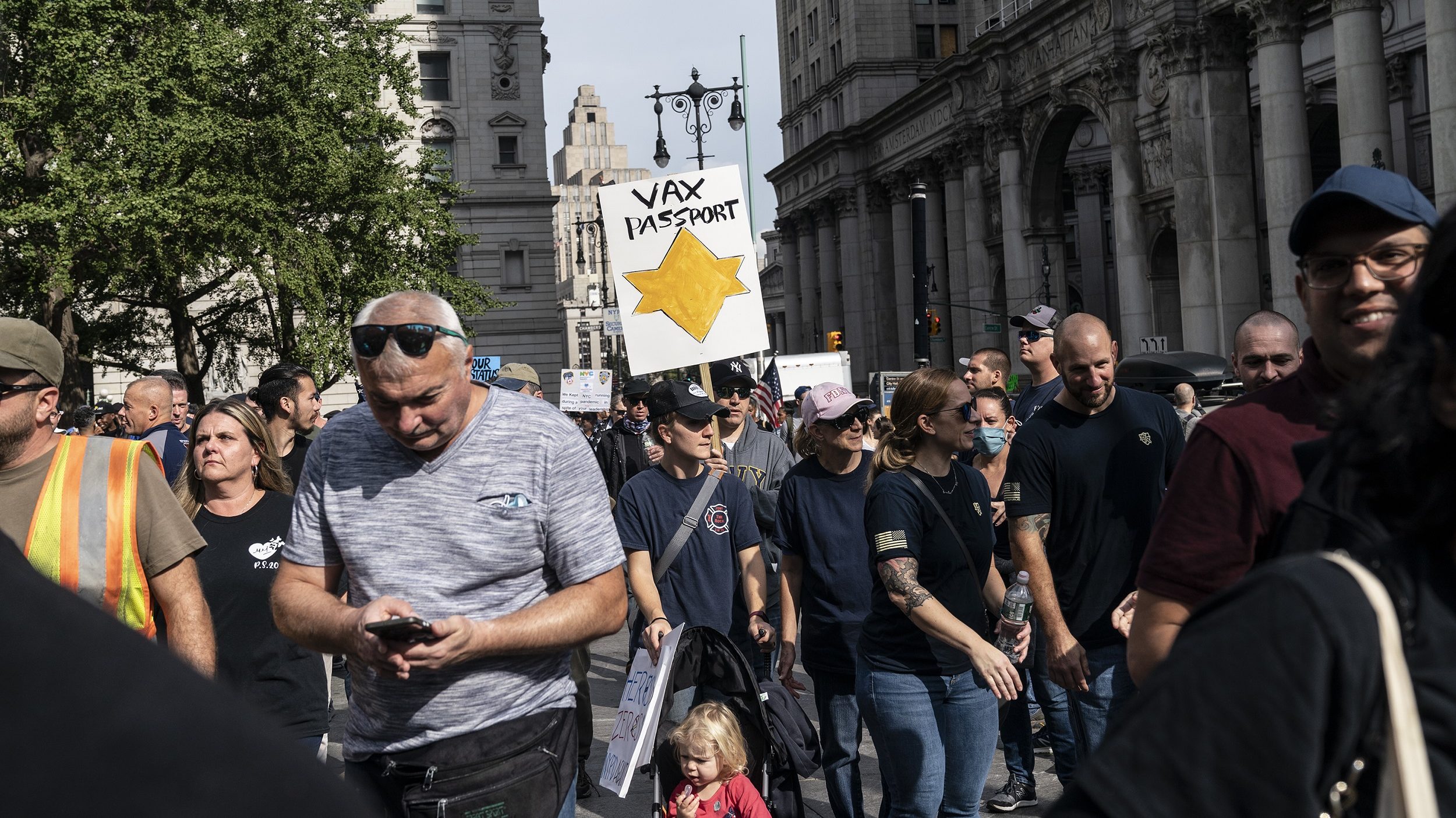COVID-19 Pandemic Unmasks American Antisemitism
Extremist groups back nonsense conspiracy theories, such as accusing Jews of creating the virus to profit from the vaccine, or comparing anti-COVID restrictions to the Holocaust
[New York] On a Sunday morning in early December, Austin resident Charles Kaufman received a small plastic bag containing some rocks and a folded document on his doorstep, a few feet away from the bundled-up newspaper usually delivered. The document was a flyer blaming Jews for the new surge of COVID-19, the same one that hundreds of homes across the country received over the past month.

Charles Kaufman at the United States Holocaust Memorial Museum in Washington, DC. (Courtesy)
“Maybe 100 or so people received it on my street, Jewish and non-Jewish,” Kaufman told The Media Line on Monday. “I was very familiar with that characterization and very well aware of it long before this flyer came out, so it was nothing new, but equally absurd.”
Distributed by a group called the Goyim Defense League, the flyers state that “every single aspect of the COVID agenda is Jewish” and include a list of Jewish COVID-19 response leaders in various institutions. The nationwide antisemitic campaign has appeared on the doorsteps of communities in California, Texas, North Carolina, Maryland, and others. According to the Anti-Defamation League, the group, whose red and black logo mimics a swastika, is a “loose network of individuals connected by their virulent antisemitism” and includes five or six primary organizers, dozens of supporters, and thousands of online followers. Founded in 2020, they also operate a video platform that streams antisemitic content. The ADL’s online resources on the group also add that its “most zealous and visible actors” are in California, Colorado, Florida and New York.

The antisemitic flyer Charles Kaufman received, blaming Jews for the new surge of COVID-19. (Courtesy)
‘It doesn’t have to make sense’
Since he received the flyer, Kaufman has been working to put together an educational campaign “explaining antisemitism and its various forms.”
“One of the things I think is really important is for the next generation of Jews to understand that these kinds of stereotypes have been around for millennia from the bubonic plague, and you can go back a long way,” he said. “This falls under the category of scapegoating and there are countless examples.”
According to Deputy Regional Director of New York/New Jersey at the Anti-Defamation League Alex Rosemberg, scapegoating has been a significant manifestation of antisemitism when it comes to the COVID-19 pandemic.
“It’s either the idea that the Jews generated the virus so that they can then generate the vaccine and create the profit as a result,” he said, “or the other aspect of this is extremist groups using symbology from the Holocaust to protest mandates.”

(Courtesy ADL)
This duality, he said, has historically been a recurring issue.
“If you are a white supremacist, then Jews are a weak-link group of people that don’t deserve to be a part of general, strong society,” he continued. “Or on the flip side, if you are more of a left-wing individual, then Jews are this all-powerful group controlling the universe.”
“Somehow antisemitism is always at the end of the scapegoat route,” Rosenberg added.
Eli Steinberg, an Orthodox Jew living in Lakewood in New Jersey, echoed Rosemberg in saying that “anything that can be exploited to hate Jews will be used to hate Jews at this point.”
Lakewood is home to a growing Orthodox Jewish population with its Beth Medrash Govoha yeshiva, the biggest in the United States. Many in this community have encountered antisemitism from their neighbors in person and online.
“You get the people who are busy saying, ‘Everybody [in the Orthodox Jewish community] is on welfare’ and then they say at the same time, ‘They have huge, beautiful houses and they’re so privileged,’” he said. “They say this at the same time, in the same breath, because [antisemitism] doesn’t have to make sense.”
Evan Bernstein, who serves as the CEO of the Community Security Service, which trains volunteers to help protect their Jewish institutions and events, has been monitoring the flyers incidents across the country. According to him, although they seem to aim at creating fear, “the fact that they are sent shows serious intent by the perpetrators.”

Community Security Service CEO Evan Bernstein (R), alongside then-Brooklyn Borough President Eric Adams, now the mayor of New York (L), after a hate crime in Brooklyn in 2019. (Courtesy)
“Without a doubt, historically we have seen that whenever a society goes through a difficult period, we as Jews tend to be more vulnerable for hatred and scapegoating,” Bernstein said. “We saw it with the measles outbreak a few years ago.”
“We need to continue to be extra vigilant,” he added.
An antisemitism pandemic
As the world went into lockdowns and restrictions in 2020, the ADL recorded 2,024 reported antisemitic incidents throughout the United States. While this is a 4% decrease from 2019, the number still represents the third-highest year on record since the organization began tracking antisemitic incidents in 1979 and as Rosemberg points out the decrease is minor, “in a year when you would have expected things to drop significantly.”
“In 2020, we saw situations at both the regional and local levels in which Jews were blamed for the spread of the virus,” the 2020 audit states. “This led to expressions of hostility and antisemitism on social media and, in some cases, real-world harassment of Jews.”

(Courtesy ADL)
In the online world, a surge in antisemitic posts was almost immediately observed. It also gave rise to a new form of harassment in the form of “Zoombombings,” in which individuals disrupted webinars with antisemitic messages and images. In 2020 ADL recorded 196 Zoombombings, some accompanied by racist and pornographic imagery. Most Zoombombing incidents appear to have been conducted by individuals without a history of notable antisemitism.
“COVID-19 has certainly not put a stop to antisemitism and the volume, nature, and scope of incidents that have struck Jewish communities and Jewish institutions since March 2020 still remains at a level that warrants us to take this very seriously,” Bernstein added. “It’s critical that we understand the stark reality of potential threats to our community so that we are in the best position to mitigate any harm.”
At the ADL, Rosenberg said it is too early to tell the effects of the surge of the omicron variant on manifestations of antisemitism, but one could expect to see more scapegoating, particularly online.
The recent flyers like the one delivered to Kaufman, he said, are “just another manifestation of something we see over and over and over again.”
Chaskel Bennett, an Orthodox Jewish community leader in New York, said dealing with antisemitism is “nothing new” year after year, but perhaps its impact is more direct today.
“Throughout history, Jews have always found themselves cast as evil villains especially at times of unrest and uncertainty,” he said. “Social media is a continuous nonstop unchecked cesspool of hate and antisemitism, where any racist misfit can propagate their anti-Semitic conspiracy theories at will with zero pushback.”
“The latest COVID variant is just a continuing trend of this ugly time,” he added.
Bennett also said he believes antisemites are “the proverbial hammer in search of a nail”: “Be it economic difficulties or a pandemic, haters will always find any pretext to imprint and disseminate their hateful ideology on the more than willing masses.”
Orthodox Jews on the front lines
In the early stages of the COVID-19 pandemic, many in the Orthodox Jewish community experienced a sort of déjà vu, a return of the same hateful rhetoric they had experienced during the 2019 measles outbreak in their communities.
Despite prominent rabbis and community leaders instructing community members to follow health guidelines, Orthodox Jews felt the media and society in general disproportionately focused on those in the community who did not respect the restrictions.
Among patterns that the ADL found on social media during those months, Orthodox Jews were the main targets of antisemitic remarks related to COVID-19. Some of the comments blamed the entire Orthodox Jewish community for spreading the virus; others suggested that Orthodox Jews should be forcibly “contained” or even denied medical treatment if they get sick.
“Why are we wasting tests and medical supplies on a community that refuses to follow the rules?” the ADL quoted from one Facebook post.
“It’s been very illuminating,” Steinberg said. He pointed out that right before the pandemic, in December and January 2019, in the aftermath of deadly attacks in a kosher market in Jersey City, New Jersey and a rabbi’s Hanukkah party in Monsey, New York, there was “an outpouring of sympathy for the Orthodox Jewish community.”
“That seemed to evaporate the second we got targeted during COVID,” he said. “It’s easy for people to pay lip service to this, and to oppose antisemitism in theory and when it’s other people who feel justified by their bigotry, but more complicated when you need to deal with your own conflicted feelings.”
“Otherwise, we are saying bigotry is justified as long the bigot feels justified,” Steinberg went on.
Bennett echoed Steinberg, saying that Orthodox Jews are not just more vulnerable to antisemitism because they are visibly Jewish, but because they also experience “extreme intolerance” from inside the Jewish community itself.
“[Other Jews] make no pretenses on just how much they dislike us and our way of life,” he said. “Danger lurks in alleyways and chat rooms alike for the lonely identifiable Jew trying to peacefully live his unassuming life in the midst of a seemingly never-ending pandemic.”
At the ADL, Rosemberg and his colleagues recorded many incidents of Orthodox Jews being blamed for “spreading the virus or not conforming to the measures that have been put in place” throughout the pandemic.
“That has contributed to things like people getting kicked out of planes for taking their masks off while eating or being discriminated against even on international flights, or multiple parties who are not related to each other, but who just happen to be wearing Orthodox garb, being all kicked off planes together because one of them was an offender,” he said.
Orthodox community members, he said, are simply “easily identifiable targets.”
“I’m going to go out and do my job and try to protect Jews regardless of whether they’re wearing long skirts and black hats or not,” Rosemberg said. “And I think everybody can come together on that idea.”

